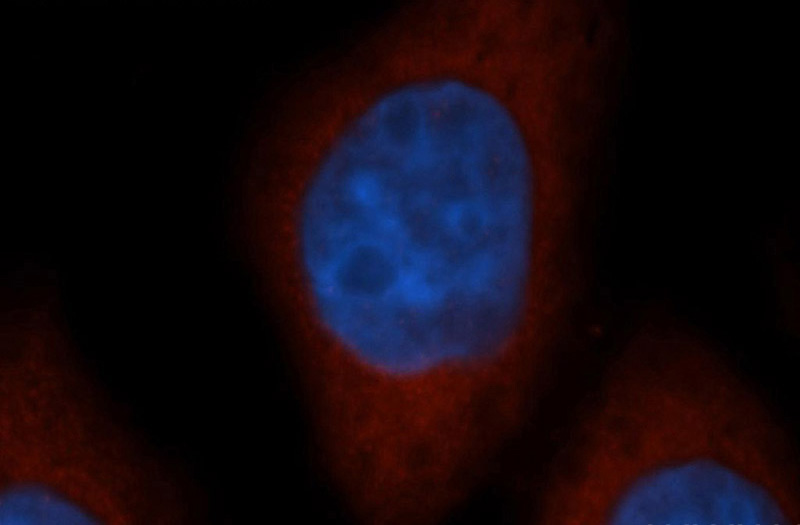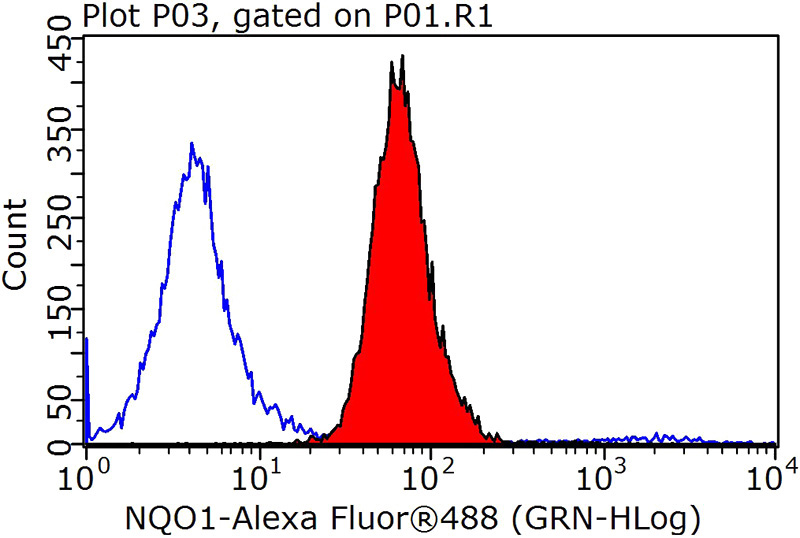-
Product Name
NQO1 antibody
- Documents
-
Description
NQO1 Rabbit Polyclonal antibody. Positive FC detected in MCF-7 cells. Positive IHC detected in human pancreas cancer tissue. Positive IF detected in MCF-7 cells. Positive WB detected in K-562 cells, HepG2 cells, MDA-MB-453s cells. Observed molecular weight by Western-blot: 31 kDa
-
Tested applications
ELISA, WB, IHC, IF, FC
-
Species reactivity
Human,Mouse,Rat; other species not tested.
-
Alternative names
Azoreductase antibody; DHQU antibody; DIA4 antibody; DT diaphorase antibody; DTD antibody; Menadione reductase antibody; NQO1 antibody; Phylloquinone reductase antibody; QR1 antibody; Quinone reductase 1 antibody
-
Isotype
Rabbit IgG
-
Preparation
This antibody was obtained by immunization of NQO1 recombinant protein (Accession Number: NM_000903). Purification method: Antigen affinity purified.
-
Clonality
Polyclonal
-
Formulation
PBS with 0.1% sodium azide and 50% glycerol pH 7.3.
-
Storage instructions
Store at -20℃. DO NOT ALIQUOT
-
Applications
Recommended Dilution:
WB: 1:500-1:5000
IHC: 1:20-1:200
IF: 1:20-1:200
-
Validations

K-562 cells were subjected to SDS PAGE followed by western blot with Catalog No:113227(NQO1 antibody) at dilution of 1:500

Immunohistochemical of paraffin-embedded human pancreas cancer using Catalog No:113227(NQO1 antibody) at dilution of 1:50 (under 10x lens)

Immunofluorescent analysis of MCF-7 cells, using NQO1 antibody Catalog No:113227 at 1:50 dilution and Rhodamine-labeled goat anti-rabbit IgG (red). Blue pseudocolor = DAPI (fluorescent DNA dye).

1X10^6 MCF-7 cells were stained with 0.2ug NQO1 antibody (Catalog No:113227, red) and control antibody (blue). Fixed with 90% MeOH blocked with 3% BSA (30 min). Alexa Fluor 488-congugated AffiniPure Goat Anti-Rabbit IgG(H+L) with dilution 1:1000.
-
Background
NQO1, also named as DIA4, NMOR1, DTD and QR1, belongs to the NAD(P)H dehydrogenase (quinone) family. This enzyme apparently serves as a quinone reductase in connection with conjugation reactions of hydroquinons involved in detoxification pathways as well as in biosynthetic processes such as the vitamin K-dependent gamma-carboxylation of glutamate residues in prothrombin synthesis. It is known to be involved in benzene metabolism. In human studies of ozone exposure, polymorphisms in oxidative stress genes (NQO1, GSTM1, GSTP1) modify respiratory symptoms, lung function, biomarkers and risk of asthma. (PMID:18511640; 18848868 ) This antibody recognizes all the three isoforms (26-27 kDa and 31 kDa) of NQO1 and the homo-dimer form (66-70 kDa) of NQO1.
-
References
- Bui CB, Shin J. Persistent expression of Nqo1 by p62-mediated Nrf2 activation facilitates p53-dependent mitotic catastrophe. Biochemical and biophysical research communications. 412(2):347-52. 2011.
- Kwon J, Han E, Bui CB. Assurance of mitochondrial integrity and mammalian longevity by the p62-Keap1-Nrf2-Nqo1 cascade. EMBO reports. 13(2):150-6. 2012.
- Wu H, Xiao Y, Zhang S. The Ets transcription factor GABP is a component of the hippo pathway essential for growth and antioxidant defense. Cell reports. 3(5):1663-77. 2013.
- Endo H, Niioka M, Kobayashi N, Tanaka M, Watanabe T. Butyrate-producing probiotics reduce nonalcoholic fatty liver disease progression in rats: new insight into the probiotics for the gut-liver axis. PloS one. 8(5):e63388. 2013.
- Lagoa R, Gañán C, López-Sánchez C, García-Martínez V, Gutierrez-Merino C. The decrease of NAD(P)H:quinone oxidoreductase 1 activity and increase of ROS production by NADPH oxidases are early biomarkers in doxorubicin cardiotoxicity. Biomarkers : biochemical indicators of exposure, response, and susceptibility to chemicals. 19(2):142-53. 2014.
- Sugiyama K, Ebinuma H, Nakamoto N. Prominent steatosis with hypermetabolism of the cell line permissive for years of infection with hepatitis C virus. PloS one. 9(4):e94460. 2014.
- Zhao F, Li K, Zhao L. Effect of Nrf2 on rat ovarian tissues against atrazine-induced anti-oxidative response. International journal of clinical and experimental pathology. 7(6):2780-9. 2014.
- Xu D, Hu L, Su C. Tetrachloro-p-benzoquinone induces hepatic oxidative damage and inflammatory response, but not apoptosis in mouse: the prevention of curcumin. Toxicology and applied pharmacology. 280(2):305-13. 2014.
Related Products / Services
Please note: All products are "FOR RESEARCH USE ONLY AND ARE NOT INTENDED FOR DIAGNOSTIC OR THERAPEUTIC USE"
